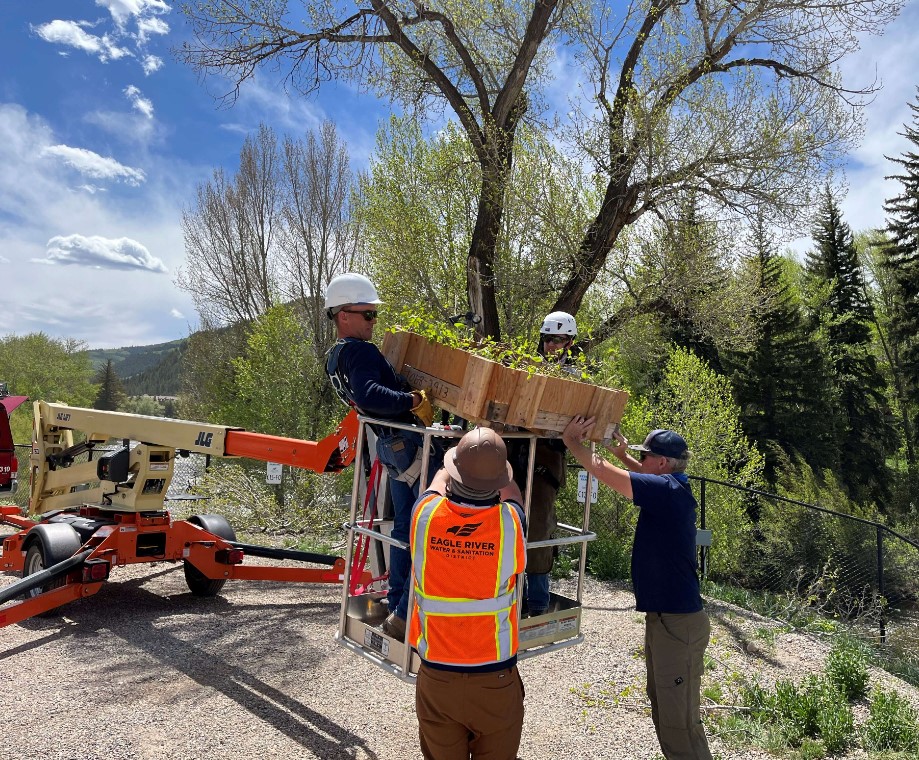Osprey Nest Successfully Relocated from Avon Construction Site
Time was of the essence this week when construction crews at the Eagle River Water & Sanitation District wastewater treatment facility in Avon found a pair of mating ospreys nesting atop one of the cranes on site.
Ospreys are protected in the United States under the federal Migratory Bird Treaty Act, which prohibits the “take” —including killing, destruction, transport and more — of the species and their nests without approval from the U.S. Fish and Wildlife Service. Colorado Parks and Wildlife also has the local authority from the federal department to make decisions around relocation of nests and the birds.

“Historically, these osprey have been a threatened and endangered species and fortunately have been brought back to sustainable populations through a lot of policies and management action,” said Layton Stutsman, the wildlife manager for Colorado Parks and Wildlife in Avon. “It’s important that we do our jobs as stewards and ensure that these osprey have a place to nest and hatch their offspring and be able to have suitable habitat and food available nearby.”
The Eagle River Water & Sanitation District construction crews immediately alerted Colorado Parks and Wildlife on Tuesday afternoon after discovering the osprey nest on top of one of the site’s cranes. The crane had been sitting idle for a few weeks at that point, giving the ospreys ample time to take advantage of it as a nesting site.
“You don’t see two large osprey flying above our wastewater treatment facility very often,” said Siri Roman, Eagle River Water and Sanitation District’s director of operations.
While the nest’s location atop of the crane made sense for a few reasons — namely its height and the hunting vantage point it offered to nearby fisheries on the Eagle River — the recent pattern of high winds, the construction activity as well as the scheduled movement of the crane off-site made it a “less than ideal location” for the nest, said Devin Duval, Colorado Park and Wildlife’s district wildlife manager.
“There’s a very real possibility that it would’ve been destroyed anyway,” he added.
On Wednesday, the construction crews from contractor Moltz Construction and local wildlife managers worked together to evaluate the situation and move forward with a plan to relocate the nest. The first thing the groups did was use a drone from the construction site to observe the nest and make sure that there weren’t already any eggs, nestlings or fledglings present — which there were not.
“Typically, we like to be wise in where we interact and interject with nature,” Stutsman said. “So, being that this is right in the middle of their nesting period, it was just a matter of time before the female laid her eggs, and given that the construction crews were able to fly their drone up and see that there were no eggs present, we wanted to act as soon as possible and get the nest down and relocate it to a site nearby.”
Duval added that because it’s mating season, and that the birds’ gestation and incubation period ranges from 4 to 6 weeks, “having a nest available to them is pretty critical so that they can start the incubation period before they fledge.”
CPW employee placing the nest structure in a tree on ERWSD property.
Eagle River Water and Sanitation District/Courtesy Photo
Typically, Duval said that in relocating these nests, Colorado Parks and Wildlife will look to fabricate a pole nearby to relocate the nest into. But, because time was of the essence in this case, the wildlife managers chose a nearby Cottonwood tree in which to move the nest.
“It was pretty necessary to move fairly quickly to try to find an alternative for them, otherwise potentially that crane couldn’t have been moved probably until mid-August or the nest would’ve just been destroyed at that point,” Duval said.
Using resources from the U.S. Forest Service, Eagle River Water & Sanitation, as well as from Colorado Parks and Wildlife, the group was able to fabricate a box nest and relocate the nest materials from crane into the Cottonwood tree.
All of this was done underneath the watchful eyes of the ospreys — which Duval said “were pretty much watching us throughout the course of that nest move.”
Ospreys have a “high fidelity to their nesting areas,” Stutsman said, meaning that they typically return — or try to return — to the same nest and area each year.
The hope is that by moving this pair’s nest as close as possible to their preferred nesting site, the ospreys will continue to utilize the nest in the Cottonwood tree.
“It was vital to pick a site nearby and make sure that it’s close enough to the river for food and for hunting — and also a high enough place for them to nest and hatch successful offspring and recruit new ospreys into the population,” Stutsman said.
Overall, the Eagle River Water and Sanitation District was eager to help out and move the nest.
“Our staff is thrilled to see the presence of osprey on our site and next to the Eagle River. As an indicator of a healthy watershed, the osprey truly are our reward for the critical work we do to protect public health and the environment,“ Roman said.
